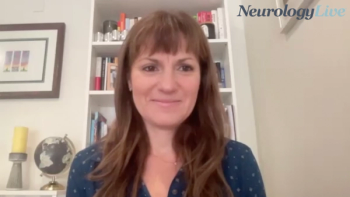
Novel Treatment Options for the Management of Narcolepsy
Margaret Park, MD, and Russell Rosenberg, PhD, DABSM, provide insight on novel FDA-approved treatment options and their impact on the narcolepsy treatment landscape.
Episodes in this series

Russell Rosenberg, PhD, DABSM: We were discussing before that there are more medications now than ever. There was a long pause between, say, the modafinil and solriamfetol and now pitolisant and the lower-sodium oxybate. What do you think of those newer options? Let’s take solriamfetol first.
Margaret Park, MD: We just talked about this. It’s exciting that there’s a new burst of things and more weapons in our arsenal to attack this disease state. It’s nice to have more things. In solriamfetol, the official stance is, “We don’t exactly know how it works,” but it’s thought to be a dopamine norepinephrine reuptake inhibitor. We know that there’s more dopamine and norepinephrine hanging around the synapse. If they’re hanging around the synapse a little more, they can mediate the wake-promoting aspect a little more. One reason I really like this medication is that it’s renally excreted. We have lots of comorbidities, and most medications go through the liver. If we have a lot of things going on in the liver, it’s nice to have an outside medicine that doesn’t depend on that hepatic metabolism as much. I do find that that aspect of that medication makes it unique and a little bit special.
Russell Rosenberg, PhD, DABSM: And it doesn’t have an impact on oral contraceptives in terms of decreasing efficacy?
Margaret Park, MD: It’s not supposed to because it’s renally excreted. I find that the interactions with hormonal contraceptives are a little less. That’s always a concern for our patients, especially with IUDs [intrauterine devices]. Being pregnant on the pill is 1 thing but being pregnant on an IUD creates a whole other set of safety concerns. In people who solely rely on an IUD, or hormonal contraception, sometimes this is a very nice method of metabolism that can mediate wakefulness without necessarily sacrificing the hormonal control that many young women need.
Russell Rosenberg, PhD, DABSM: Pitolisant isn’t the newest kid on the block, but it’s 1 of the newer ones. How often have you used it, and what have been your findings with your patients?
Margaret Park, MD: I like it a lot. As you know, it’s a histamine-based medication, so it manipulates a specific receptor within the histamine system. It’s outside that traditional adrenergic type of system, which is nice. In case 2, we’re concerned about dose escalation, tolerance, and abuse potential, but with the histamine group, we don’t see that as much. It’s 1 of the only nonscheduled substances that we have within that arsenal of narcolepsy treatment. It just works a little differently.
Going back to the mechanism of action, I don’t want to constantly hit that adrenergic system too much. If I’m going outside the histamine system, that can work laterally or possibly strengthen that weakened orexigenic system to mediate the same signaling to these weak promoters without directly affecting them. It’s an exciting new way of conceptualizing the disorder and managing this disorder.
I tell patients that this is more of a chronic thing. It’s a maintenance medication. You take it every day, and then, 2 to 8 weeks later, you will then get a response. Unlike these medicines, which you can take and feel something, and then it wears off, this is something you take daily to change how your wakefulness feels. That platform feels a little different. They may still need other medication to supplement their wakefulness. But often I find that they need these other medications, maybe in fewer doses or less frequently, because their overall wakefulness platform is just a little elevated. I do like it a lot. It’s an exciting new way to think about disease management.
Russell Rosenberg, PhD, DABSM: There are a lot of common stories about it…. You’re right in giving them the expectation, it might take a few weeks. But it’s also not going to be the hammer that an amphetamine is because you’re not going to feel that punch right away. It’s something that works over- time. A few patients reported that it wasn’t working that great for them. Then they went through and came back weeks later saying, “Now that I think about it, I was a lot sharper. I was on my game more. Can you put me back on that?” The improvements take time to understand. For all medications, taking the proper time to meet expectations is important.
Margaret Park, MD: That’s really important. It’s interesting because I see that a lot in my patients. You put them on something, and they say, “Nope, it didn’t help.” Then you’re like, “You know what? Take a week or 2 off it. Then they’re like, “It was helping.” A lot of times, we don’t know. Just as a species, we don’t notice the benefit until we feel the loss of it. Then we recognize that there was a benefit. Subsequently, a lot of times, it’s about managing that patient expectation and giving them a rudimentary knowledge of what it’s doing. A lot of times people think, “I take this medicine, so it should be cured.” And I’m like, “No, that’s not how it works.” We see that with diabetes. They’re like, “My sugars were normal, so I stopped it.” I’m like, “No, it was only normal because you were taking the medicine. The medicine modulated the disease, but the disease is still there.”
It’s important to tell them what it’s doing. It may be subtle. That’s where the benchmarks come in. What do you think you want to do? What have you been able to do now that you weren’t doing before? It can be as subtle as making it through most of that movie after dinner with my significant other, whereas before I never was able to stay awake till the end. We encourage people to realize that sometimes subtle changes are better. Because that means it’s changing your overall perspective, your body’s perspective, and your brain’s perspective of what it means to be alert and awake and involved. It might not be like, “I’m on it,” it wears off, and then “I’m down.” It might be a gradual enlightenment. It’s like losing half a pound a month. You don’t notice it initially, but after 2 years, you’ve lost a lot of weight.
Transcript Edited for Clarity
Newsletter
Keep your finger on the pulse of neurology—subscribe to NeurologyLive for expert interviews, new data, and breakthrough treatment updates.




















